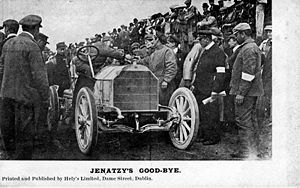FROM THE HISTORY OF CAR RACING

The human desire to compete naturally also manifested itself with the beginnings of motorization. Car, embodying strength, speed and endurance became an excellent means of competition in the new discipline – motor sport. Pomimo to, that the motives for organizing the first competitions and races are ambiguous from the current point of view, definitely sporting competition in the full sense of the word played an important role alongside advertising goals, personal prestige or love of risk.
The first car events were not races with complicated rules, which are in force today. If we are to start all over again, priority should be given to palm trees at the event, which can hardly be considered racing. It was announced in 1887 of the year, the French magazine "Le Vélocipéde” as official public races held in the suburbs of Paris for vehicles driven by another force, than human or animal. The races were held on a closed circuit and could become the first in the world, if it were not for one pathetic fact: one and only competitor participated in the event – steam car de Dion-Bouton. The following year races were organized again (this time there were two participants – by Dion-Bouton i Serpollet), unfortunately, they did not receive the necessary publicity and were temporarily forgotten, and the development of motor sports went in a different direction - races began to be organized on routes between cities. The year became the decisive year in this period 1894, in which the publishing house "Le Petit Journal”, and on his behalf the editor-in-chief Pierre Giffard announced the racing of "vehicles without horses”. The route was marked out between Paris and the distant Fr. 126 km Rouen. The races were not competitive in terms of speed, they only promised an unusual show. Meanwhile, contrary to the ideas of Mr. Giffard, propaganda, the solemn car parade has turned into a real race. Count Albert de Dion was the first to appear in Rouen with time 6 hours 48 minutes after take off, which was the average speed 18,7 km/h. However, the main prize – 5000 francs in gold – was split between Peugeot and Panhard-Levassor cars, in which, unlike the Albert de Dion steam drive, Daimler two-cylinder V-engines were used. Peugeot cars were driven by Lemaitre and Dorion, Panhard-Levassor cars - personally the owners of the company, René Panhard i Emile Levassor. The second prize went to de Dion, the third was Emil Roger driving a Benz car, who was the representative of this company in France.
At the end of this year, plans for a great event were already being prepared, destined to eclipse previous races. A track of total length 1178 km was to be the Paris-Bordeaux-Paris route. June eleventh 1895 r. from Place d'Armes in Versailles, the participants of the world's first official car races started, favorites in between 22 cars, seven of which were to divide the sum 70 000 francs, There were Peugeot and Panhard-Levassor cars again. A Peugeot car called "L'Eclair" was driving outside the competition”, modernized by the use of Miche-lin tires. The first was in Paris by Emile Levassor, however the official winner was Koechlin, in a Peugeot driving car, because the Levassor's vehicle was a two-seater - not a four-seater, as required by the regulations.
This type of competition between cities became extremely popular, and the race started from Paris every year since then.
It was interesting to gradually increase the speed and power of the vehicles, most evident in the development of the Panhard-Levassor cars dominating the racing up to 1899 year. These cars a year 1895 they had power 2,94 kW (4 KM) and achieved an average speed 24,2 km/h, while the model from the year 1899 he had the power 11,8 kW (16 KM) and the average speed measured at the Paris Bordeaux races was 49,4 km/h.
At the beginning of our century, the fast Morsy and Renaults with engines of approx 51,5 kW (70 KM), reaching a maximum speed of over 100 km/h.
W 1899 in the New York Herald”, also going out in Paris, rules for new motor racing have been published, named after the Gordon Bennett Cup after their organizer, who is also the owner of the newspaper. Under these rules, the minimum vehicle weight was limited to 400 kg, and the maximum to 1000 kg. The length of the route is set at 550-650 km. For the first time the Gordon Bennett Cup was held on the Paris-Lyon route, and the winner was Charron driving a Panhard-Levassor car.